Dell's Strategic Challenges and Opportunities: Case Study Analysis
VerifiedAdded on 2022/09/05
|24
|4260
|29
Case Study
AI Summary
This case study analyzes Dell's strategic journey, from its early dominance in the PC market to the challenges it faced due to changing consumer behavior and increased competition from companies like Lenovo and Apple. The report examines Dell's competitive advantages, including its direct sales model and just-in-time delivery, using VRIN analysis to assess their sustainability. It evaluates the impact of industry changes on Dell and explores its expansion into enterprise solutions and services, including the challenges of acquisitions and integration strategies. The study critically assesses Dell's strategies, emphasizing the importance of innovation, and uses the BCG matrix to propose strategic options for the company's future. The analysis highlights Dell's need to adapt to remain competitive in the evolving technology landscape.
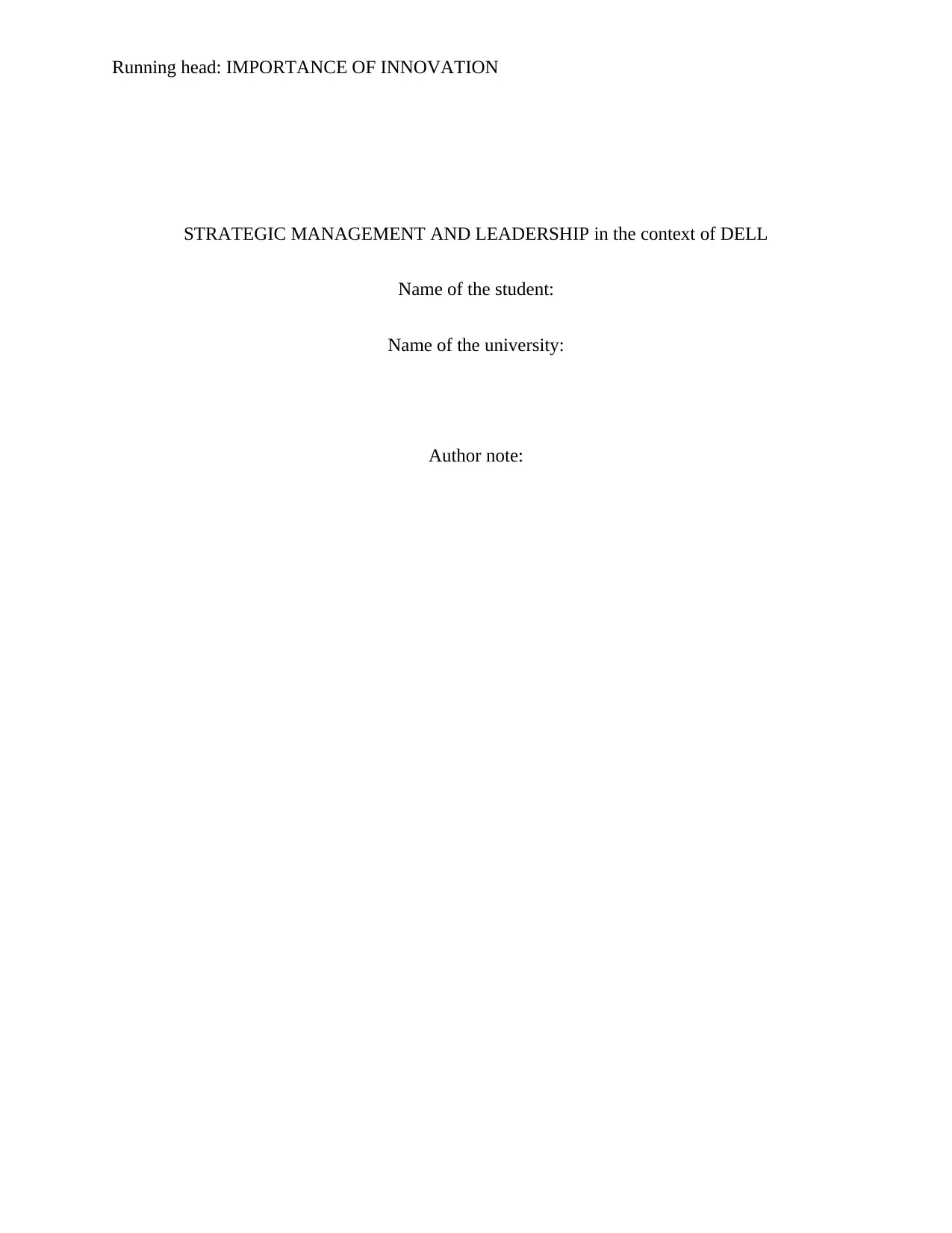
Running head: IMPORTANCE OF INNOVATION
STRATEGIC MANAGEMENT AND LEADERSHIP in the context of DELL
Name of the student:
Name of the university:
Author note:
STRATEGIC MANAGEMENT AND LEADERSHIP in the context of DELL
Name of the student:
Name of the university:
Author note:
Paraphrase This Document
Need a fresh take? Get an instant paraphrase of this document with our AI Paraphraser
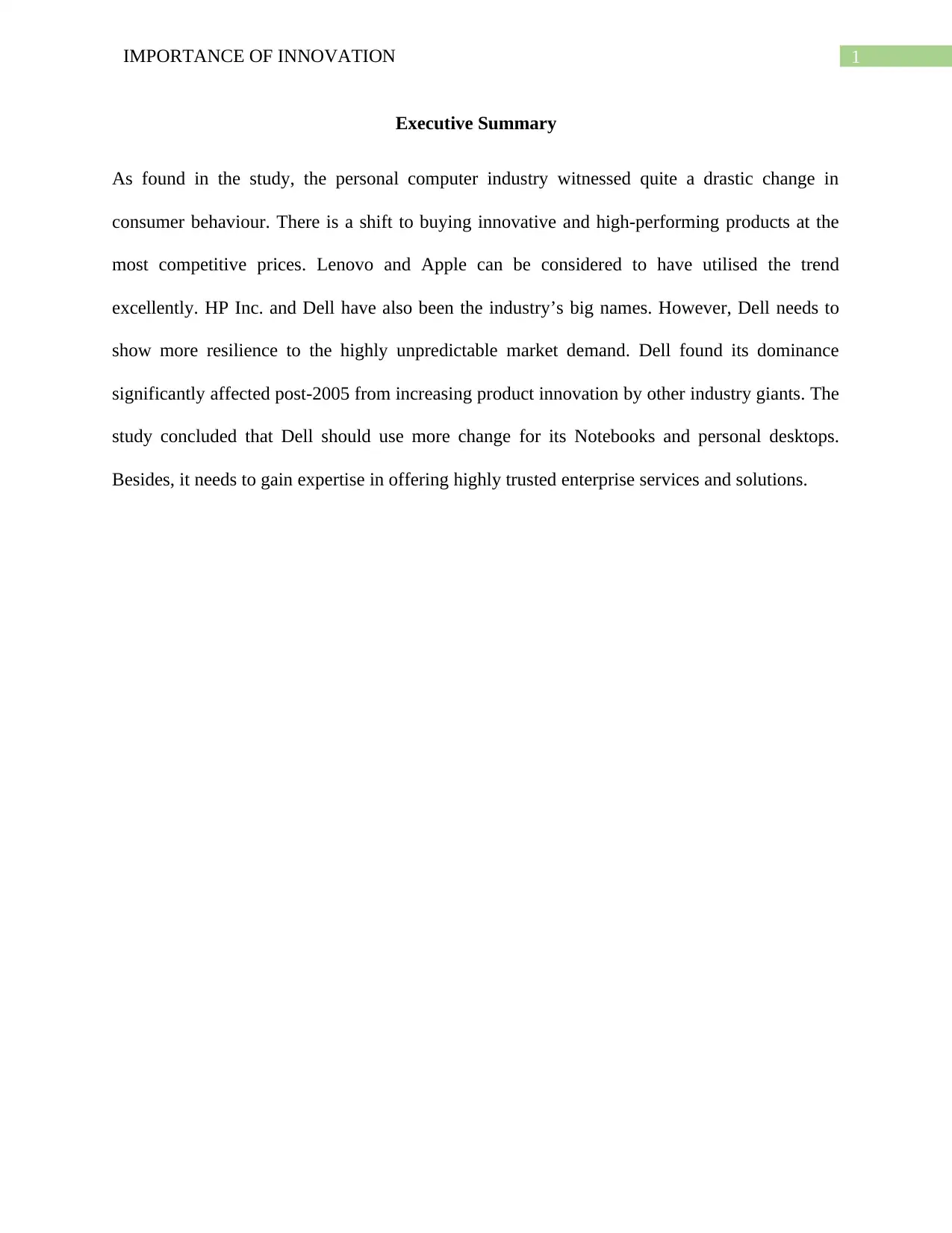
1IMPORTANCE OF INNOVATION
Executive Summary
As found in the study, the personal computer industry witnessed quite a drastic change in
consumer behaviour. There is a shift to buying innovative and high-performing products at the
most competitive prices. Lenovo and Apple can be considered to have utilised the trend
excellently. HP Inc. and Dell have also been the industry’s big names. However, Dell needs to
show more resilience to the highly unpredictable market demand. Dell found its dominance
significantly affected post-2005 from increasing product innovation by other industry giants. The
study concluded that Dell should use more change for its Notebooks and personal desktops.
Besides, it needs to gain expertise in offering highly trusted enterprise services and solutions.
Executive Summary
As found in the study, the personal computer industry witnessed quite a drastic change in
consumer behaviour. There is a shift to buying innovative and high-performing products at the
most competitive prices. Lenovo and Apple can be considered to have utilised the trend
excellently. HP Inc. and Dell have also been the industry’s big names. However, Dell needs to
show more resilience to the highly unpredictable market demand. Dell found its dominance
significantly affected post-2005 from increasing product innovation by other industry giants. The
study concluded that Dell should use more change for its Notebooks and personal desktops.
Besides, it needs to gain expertise in offering highly trusted enterprise services and solutions.

2IMPORTANCE OF INNOVATION
Table of Contents
Introduction......................................................................................................................................4
Brief profile of Dell.....................................................................................................................4
Analyse how the industry has changed over the last few years and assess the impact of such
changes on Dell............................................................................................................................5
Purpose of the report....................................................................................................................7
Body.................................................................................................................................................7
1. Evaluate the sustainable competitive advantages of Dell.........................................7 critically
1.1 VRIN analysis....................................................................................................................7
1.2 Identify the competitive advantages of Dell....................................................................10
1.3 How these capabilities will/will not support the new service ‘Enterprise Solutions and
Services..................................................................................................................................11
2. Challenges to be faced by Dell from its expansion in the area of ‘Enterprise solutions and
services’.....................................................................................................................................12
2.1 Dell's critical acquisitions in the case study....................................................................12
2.2 The key issues/challenges in any acquisition..................................................................12
2.3 Using the Integration matrix to identify the type of integration should Dell adopt........13
2.4 The advantages/disadvantages exist for each example of integration strategy suggested
...............................................................................................................................................14
3. A critical commentary upon the Dell strategies....................................................................16
3.1 The importance of innovation to this industry.................................................................16
Table of Contents
Introduction......................................................................................................................................4
Brief profile of Dell.....................................................................................................................4
Analyse how the industry has changed over the last few years and assess the impact of such
changes on Dell............................................................................................................................5
Purpose of the report....................................................................................................................7
Body.................................................................................................................................................7
1. Evaluate the sustainable competitive advantages of Dell.........................................7 critically
1.1 VRIN analysis....................................................................................................................7
1.2 Identify the competitive advantages of Dell....................................................................10
1.3 How these capabilities will/will not support the new service ‘Enterprise Solutions and
Services..................................................................................................................................11
2. Challenges to be faced by Dell from its expansion in the area of ‘Enterprise solutions and
services’.....................................................................................................................................12
2.1 Dell's critical acquisitions in the case study....................................................................12
2.2 The key issues/challenges in any acquisition..................................................................12
2.3 Using the Integration matrix to identify the type of integration should Dell adopt........13
2.4 The advantages/disadvantages exist for each example of integration strategy suggested
...............................................................................................................................................14
3. A critical commentary upon the Dell strategies....................................................................16
3.1 The importance of innovation to this industry.................................................................16
⊘ This is a preview!⊘
Do you want full access?
Subscribe today to unlock all pages.

Trusted by 1+ million students worldwide
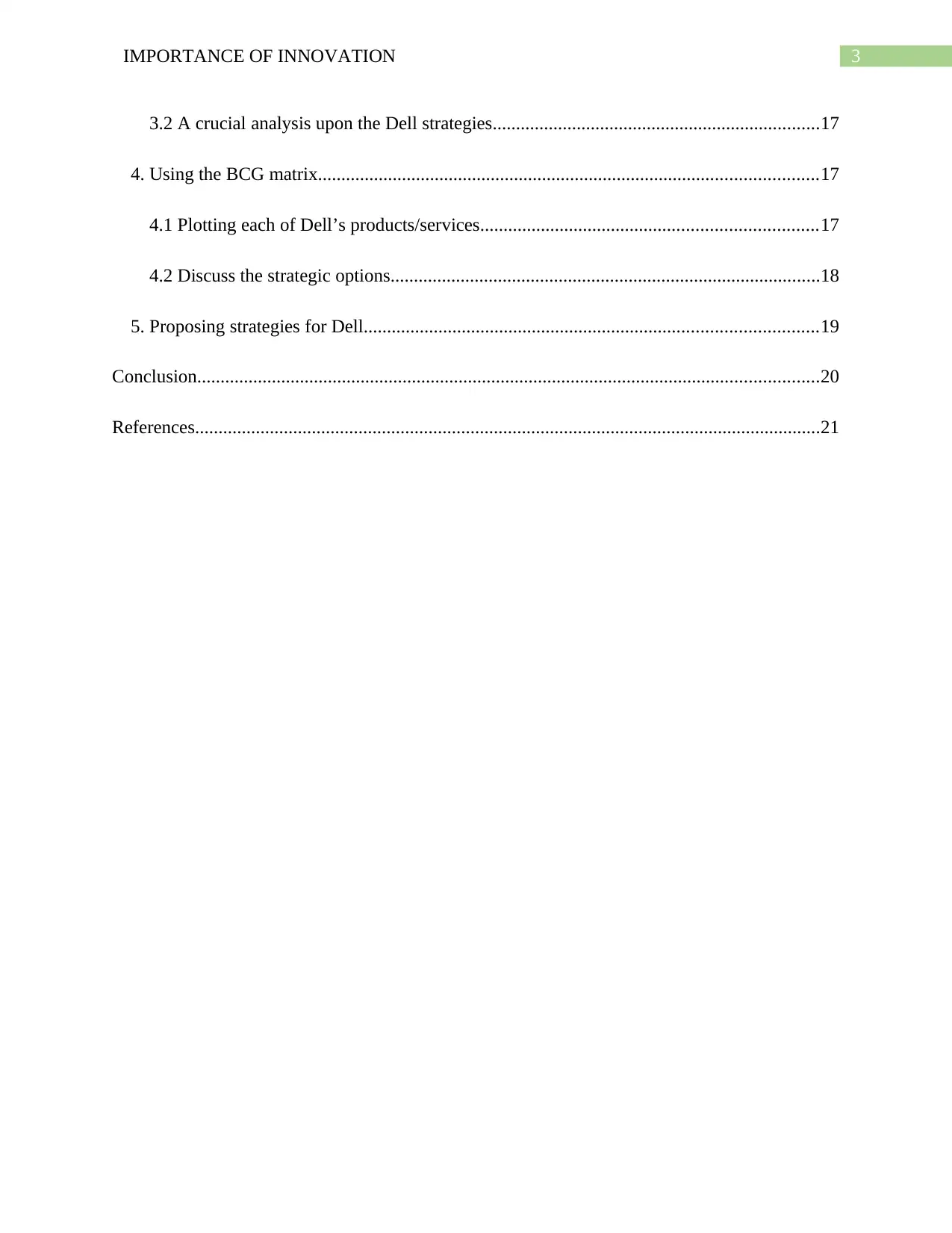
3IMPORTANCE OF INNOVATION
3.2 A crucial analysis upon the Dell strategies......................................................................17
4. Using the BCG matrix...........................................................................................................17
4.1 Plotting each of Dell’s products/services........................................................................17
4.2 Discuss the strategic options............................................................................................18
5. Proposing strategies for Dell.................................................................................................19
Conclusion.....................................................................................................................................20
References......................................................................................................................................21
3.2 A crucial analysis upon the Dell strategies......................................................................17
4. Using the BCG matrix...........................................................................................................17
4.1 Plotting each of Dell’s products/services........................................................................17
4.2 Discuss the strategic options............................................................................................18
5. Proposing strategies for Dell.................................................................................................19
Conclusion.....................................................................................................................................20
References......................................................................................................................................21
Paraphrase This Document
Need a fresh take? Get an instant paraphrase of this document with our AI Paraphraser
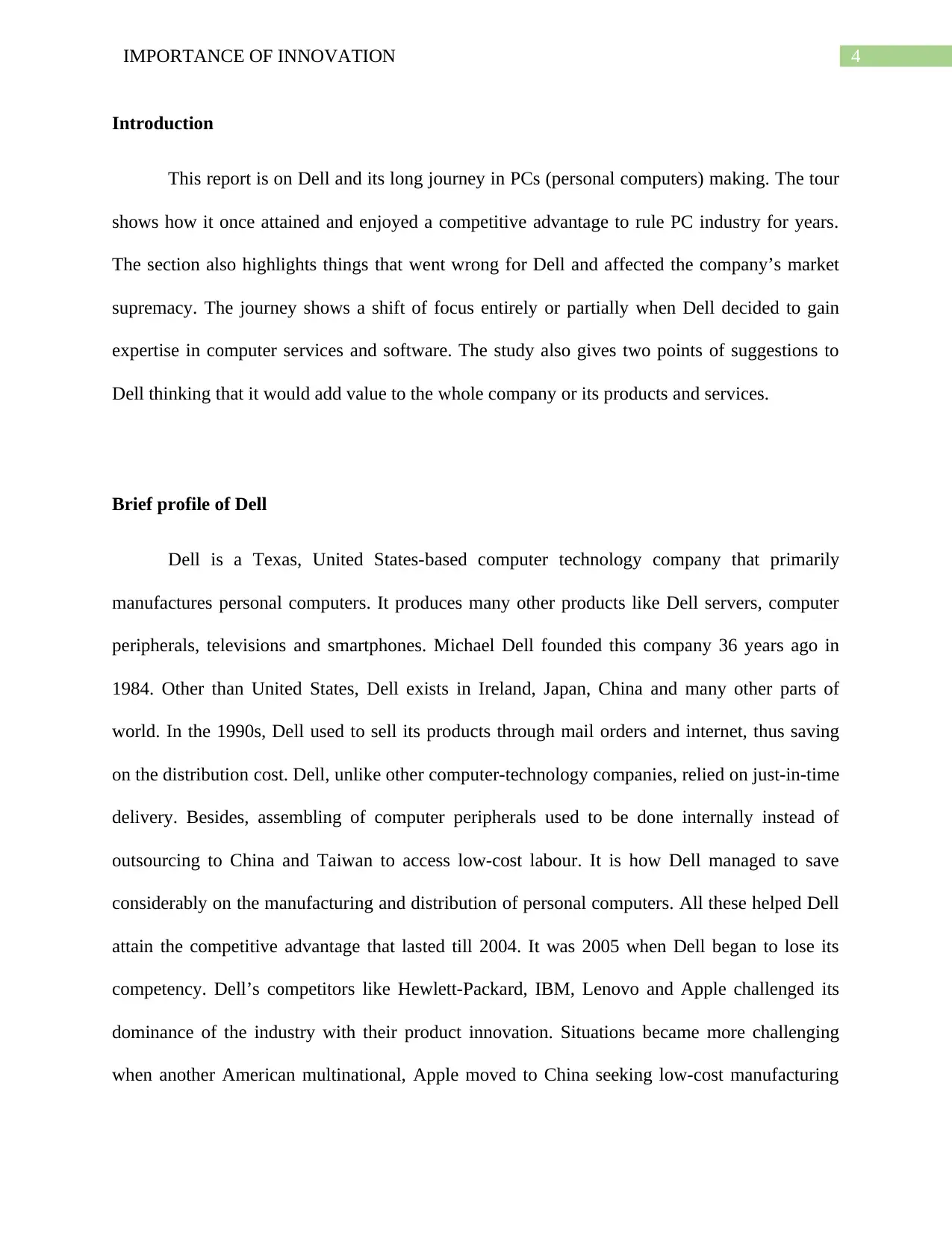
4IMPORTANCE OF INNOVATION
Introduction
This report is on Dell and its long journey in PCs (personal computers) making. The tour
shows how it once attained and enjoyed a competitive advantage to rule PC industry for years.
The section also highlights things that went wrong for Dell and affected the company’s market
supremacy. The journey shows a shift of focus entirely or partially when Dell decided to gain
expertise in computer services and software. The study also gives two points of suggestions to
Dell thinking that it would add value to the whole company or its products and services.
Brief profile of Dell
Dell is a Texas, United States-based computer technology company that primarily
manufactures personal computers. It produces many other products like Dell servers, computer
peripherals, televisions and smartphones. Michael Dell founded this company 36 years ago in
1984. Other than United States, Dell exists in Ireland, Japan, China and many other parts of
world. In the 1990s, Dell used to sell its products through mail orders and internet, thus saving
on the distribution cost. Dell, unlike other computer-technology companies, relied on just-in-time
delivery. Besides, assembling of computer peripherals used to be done internally instead of
outsourcing to China and Taiwan to access low-cost labour. It is how Dell managed to save
considerably on the manufacturing and distribution of personal computers. All these helped Dell
attain the competitive advantage that lasted till 2004. It was 2005 when Dell began to lose its
competency. Dell’s competitors like Hewlett-Packard, IBM, Lenovo and Apple challenged its
dominance of the industry with their product innovation. Situations became more challenging
when another American multinational, Apple moved to China seeking low-cost manufacturing
Introduction
This report is on Dell and its long journey in PCs (personal computers) making. The tour
shows how it once attained and enjoyed a competitive advantage to rule PC industry for years.
The section also highlights things that went wrong for Dell and affected the company’s market
supremacy. The journey shows a shift of focus entirely or partially when Dell decided to gain
expertise in computer services and software. The study also gives two points of suggestions to
Dell thinking that it would add value to the whole company or its products and services.
Brief profile of Dell
Dell is a Texas, United States-based computer technology company that primarily
manufactures personal computers. It produces many other products like Dell servers, computer
peripherals, televisions and smartphones. Michael Dell founded this company 36 years ago in
1984. Other than United States, Dell exists in Ireland, Japan, China and many other parts of
world. In the 1990s, Dell used to sell its products through mail orders and internet, thus saving
on the distribution cost. Dell, unlike other computer-technology companies, relied on just-in-time
delivery. Besides, assembling of computer peripherals used to be done internally instead of
outsourcing to China and Taiwan to access low-cost labour. It is how Dell managed to save
considerably on the manufacturing and distribution of personal computers. All these helped Dell
attain the competitive advantage that lasted till 2004. It was 2005 when Dell began to lose its
competency. Dell’s competitors like Hewlett-Packard, IBM, Lenovo and Apple challenged its
dominance of the industry with their product innovation. Situations became more challenging
when another American multinational, Apple moved to China seeking low-cost manufacturing
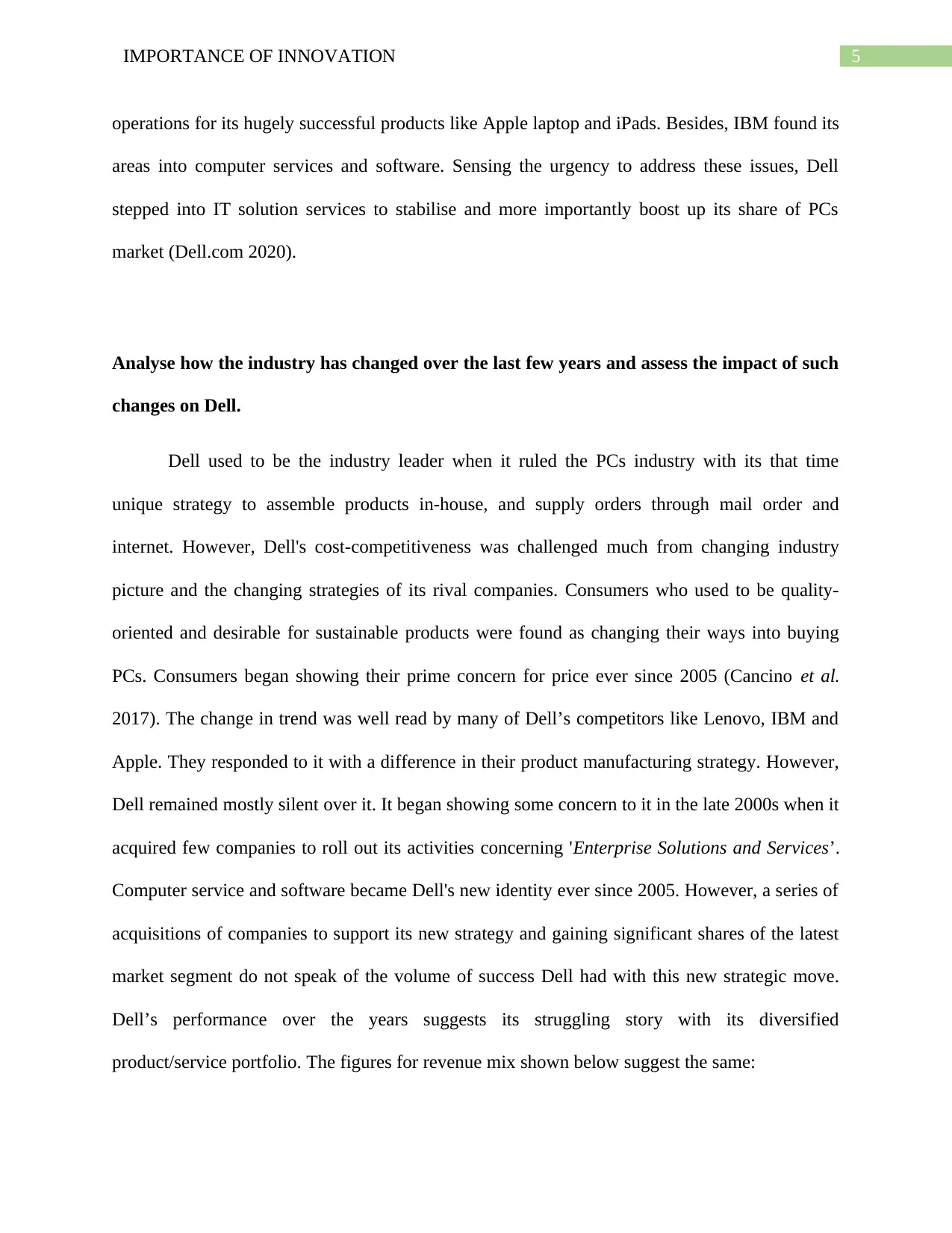
5IMPORTANCE OF INNOVATION
operations for its hugely successful products like Apple laptop and iPads. Besides, IBM found its
areas into computer services and software. Sensing the urgency to address these issues, Dell
stepped into IT solution services to stabilise and more importantly boost up its share of PCs
market (Dell.com 2020).
Analyse how the industry has changed over the last few years and assess the impact of such
changes on Dell.
Dell used to be the industry leader when it ruled the PCs industry with its that time
unique strategy to assemble products in-house, and supply orders through mail order and
internet. However, Dell's cost-competitiveness was challenged much from changing industry
picture and the changing strategies of its rival companies. Consumers who used to be quality-
oriented and desirable for sustainable products were found as changing their ways into buying
PCs. Consumers began showing their prime concern for price ever since 2005 (Cancino et al.
2017). The change in trend was well read by many of Dell’s competitors like Lenovo, IBM and
Apple. They responded to it with a difference in their product manufacturing strategy. However,
Dell remained mostly silent over it. It began showing some concern to it in the late 2000s when it
acquired few companies to roll out its activities concerning 'Enterprise Solutions and Services’.
Computer service and software became Dell's new identity ever since 2005. However, a series of
acquisitions of companies to support its new strategy and gaining significant shares of the latest
market segment do not speak of the volume of success Dell had with this new strategic move.
Dell’s performance over the years suggests its struggling story with its diversified
product/service portfolio. The figures for revenue mix shown below suggest the same:
operations for its hugely successful products like Apple laptop and iPads. Besides, IBM found its
areas into computer services and software. Sensing the urgency to address these issues, Dell
stepped into IT solution services to stabilise and more importantly boost up its share of PCs
market (Dell.com 2020).
Analyse how the industry has changed over the last few years and assess the impact of such
changes on Dell.
Dell used to be the industry leader when it ruled the PCs industry with its that time
unique strategy to assemble products in-house, and supply orders through mail order and
internet. However, Dell's cost-competitiveness was challenged much from changing industry
picture and the changing strategies of its rival companies. Consumers who used to be quality-
oriented and desirable for sustainable products were found as changing their ways into buying
PCs. Consumers began showing their prime concern for price ever since 2005 (Cancino et al.
2017). The change in trend was well read by many of Dell’s competitors like Lenovo, IBM and
Apple. They responded to it with a difference in their product manufacturing strategy. However,
Dell remained mostly silent over it. It began showing some concern to it in the late 2000s when it
acquired few companies to roll out its activities concerning 'Enterprise Solutions and Services’.
Computer service and software became Dell's new identity ever since 2005. However, a series of
acquisitions of companies to support its new strategy and gaining significant shares of the latest
market segment do not speak of the volume of success Dell had with this new strategic move.
Dell’s performance over the years suggests its struggling story with its diversified
product/service portfolio. The figures for revenue mix shown below suggest the same:
⊘ This is a preview!⊘
Do you want full access?
Subscribe today to unlock all pages.

Trusted by 1+ million students worldwide
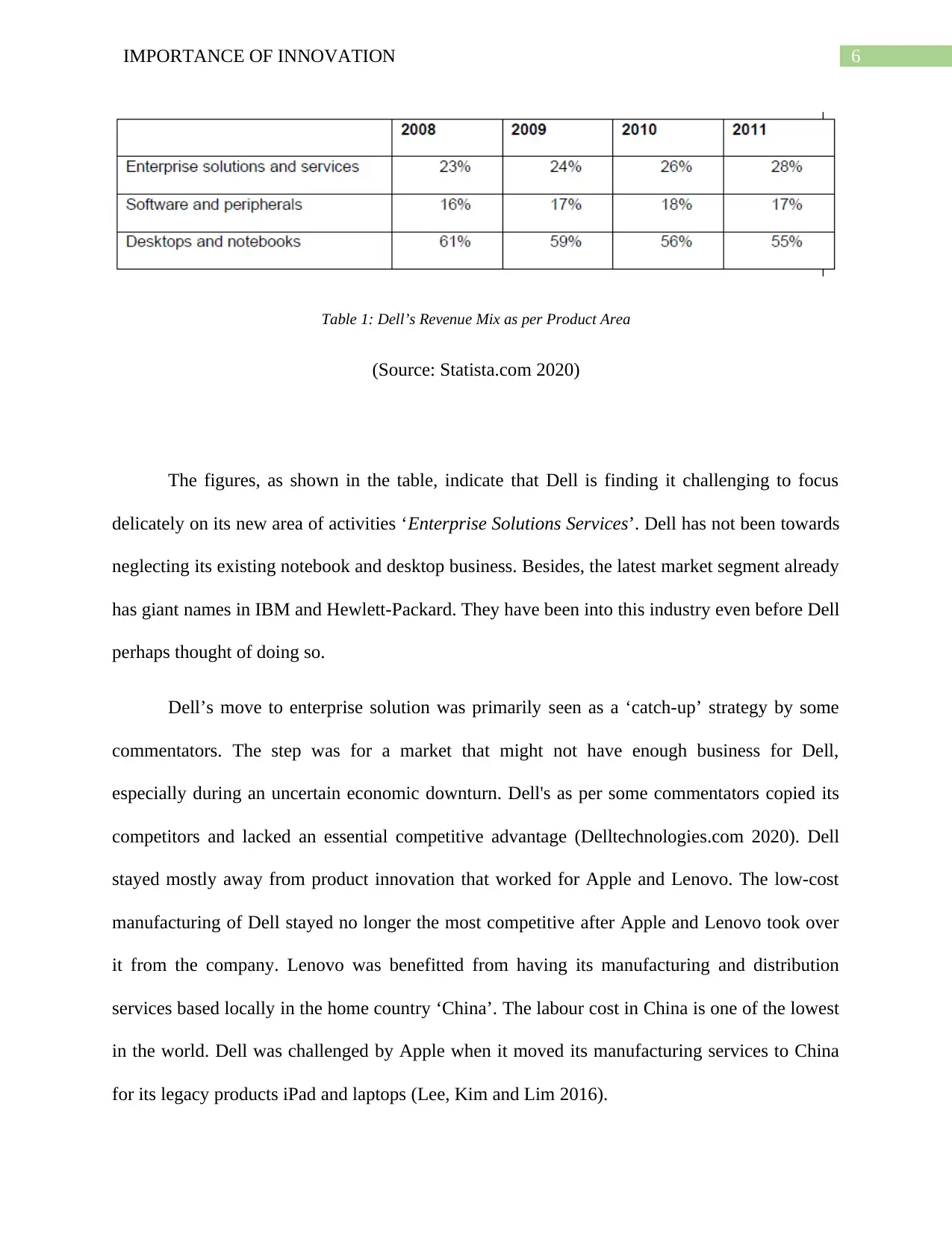
6IMPORTANCE OF INNOVATION
Table 1: Dell’s Revenue Mix as per Product Area
(Source: Statista.com 2020)
The figures, as shown in the table, indicate that Dell is finding it challenging to focus
delicately on its new area of activities ‘Enterprise Solutions Services’. Dell has not been towards
neglecting its existing notebook and desktop business. Besides, the latest market segment already
has giant names in IBM and Hewlett-Packard. They have been into this industry even before Dell
perhaps thought of doing so.
Dell’s move to enterprise solution was primarily seen as a ‘catch-up’ strategy by some
commentators. The step was for a market that might not have enough business for Dell,
especially during an uncertain economic downturn. Dell's as per some commentators copied its
competitors and lacked an essential competitive advantage (Delltechnologies.com 2020). Dell
stayed mostly away from product innovation that worked for Apple and Lenovo. The low-cost
manufacturing of Dell stayed no longer the most competitive after Apple and Lenovo took over
it from the company. Lenovo was benefitted from having its manufacturing and distribution
services based locally in the home country ‘China’. The labour cost in China is one of the lowest
in the world. Dell was challenged by Apple when it moved its manufacturing services to China
for its legacy products iPad and laptops (Lee, Kim and Lim 2016).
Table 1: Dell’s Revenue Mix as per Product Area
(Source: Statista.com 2020)
The figures, as shown in the table, indicate that Dell is finding it challenging to focus
delicately on its new area of activities ‘Enterprise Solutions Services’. Dell has not been towards
neglecting its existing notebook and desktop business. Besides, the latest market segment already
has giant names in IBM and Hewlett-Packard. They have been into this industry even before Dell
perhaps thought of doing so.
Dell’s move to enterprise solution was primarily seen as a ‘catch-up’ strategy by some
commentators. The step was for a market that might not have enough business for Dell,
especially during an uncertain economic downturn. Dell's as per some commentators copied its
competitors and lacked an essential competitive advantage (Delltechnologies.com 2020). Dell
stayed mostly away from product innovation that worked for Apple and Lenovo. The low-cost
manufacturing of Dell stayed no longer the most competitive after Apple and Lenovo took over
it from the company. Lenovo was benefitted from having its manufacturing and distribution
services based locally in the home country ‘China’. The labour cost in China is one of the lowest
in the world. Dell was challenged by Apple when it moved its manufacturing services to China
for its legacy products iPad and laptops (Lee, Kim and Lim 2016).
Paraphrase This Document
Need a fresh take? Get an instant paraphrase of this document with our AI Paraphraser
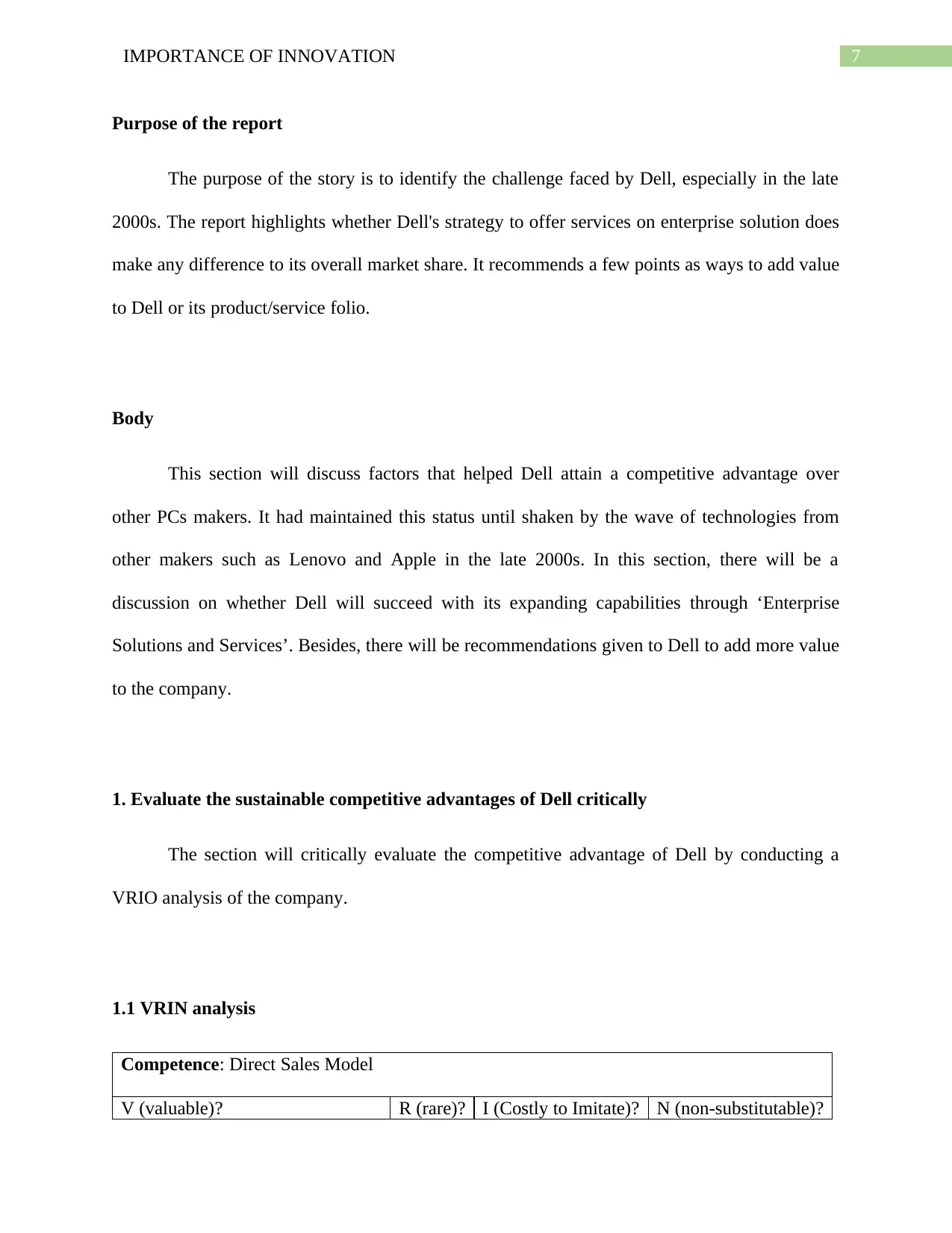
7IMPORTANCE OF INNOVATION
Purpose of the report
The purpose of the story is to identify the challenge faced by Dell, especially in the late
2000s. The report highlights whether Dell's strategy to offer services on enterprise solution does
make any difference to its overall market share. It recommends a few points as ways to add value
to Dell or its product/service folio.
Body
This section will discuss factors that helped Dell attain a competitive advantage over
other PCs makers. It had maintained this status until shaken by the wave of technologies from
other makers such as Lenovo and Apple in the late 2000s. In this section, there will be a
discussion on whether Dell will succeed with its expanding capabilities through ‘Enterprise
Solutions and Services’. Besides, there will be recommendations given to Dell to add more value
to the company.
1. Evaluate the sustainable competitive advantages of Dell critically
The section will critically evaluate the competitive advantage of Dell by conducting a
VRIO analysis of the company.
1.1 VRIN analysis
Competence: Direct Sales Model
V (valuable)? R (rare)? I (Costly to Imitate)? N (non-substitutable)?
Purpose of the report
The purpose of the story is to identify the challenge faced by Dell, especially in the late
2000s. The report highlights whether Dell's strategy to offer services on enterprise solution does
make any difference to its overall market share. It recommends a few points as ways to add value
to Dell or its product/service folio.
Body
This section will discuss factors that helped Dell attain a competitive advantage over
other PCs makers. It had maintained this status until shaken by the wave of technologies from
other makers such as Lenovo and Apple in the late 2000s. In this section, there will be a
discussion on whether Dell will succeed with its expanding capabilities through ‘Enterprise
Solutions and Services’. Besides, there will be recommendations given to Dell to add more value
to the company.
1. Evaluate the sustainable competitive advantages of Dell critically
The section will critically evaluate the competitive advantage of Dell by conducting a
VRIO analysis of the company.
1.1 VRIN analysis
Competence: Direct Sales Model
V (valuable)? R (rare)? I (Costly to Imitate)? N (non-substitutable)?
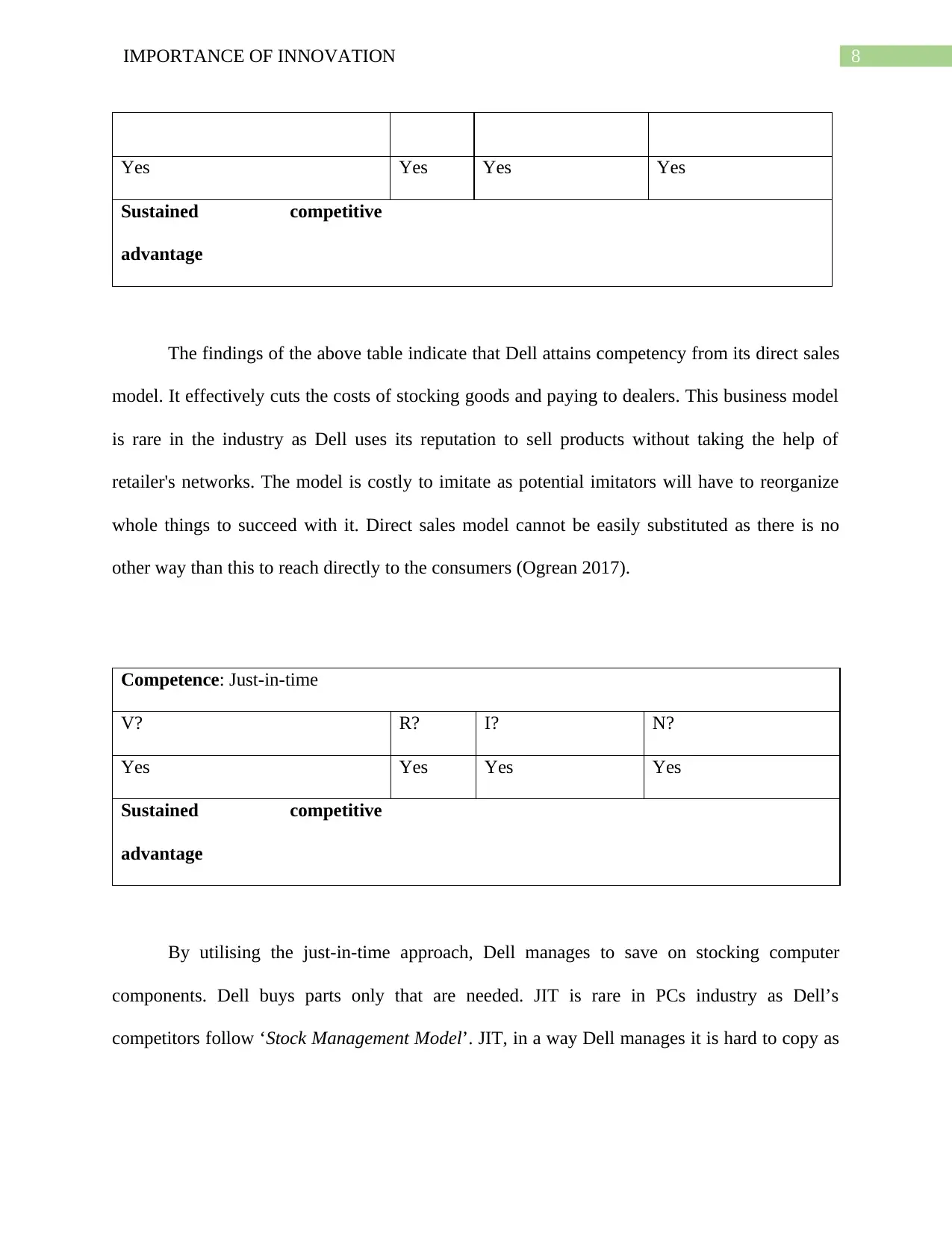
8IMPORTANCE OF INNOVATION
Yes Yes Yes Yes
Sustained competitive
advantage
The findings of the above table indicate that Dell attains competency from its direct sales
model. It effectively cuts the costs of stocking goods and paying to dealers. This business model
is rare in the industry as Dell uses its reputation to sell products without taking the help of
retailer's networks. The model is costly to imitate as potential imitators will have to reorganize
whole things to succeed with it. Direct sales model cannot be easily substituted as there is no
other way than this to reach directly to the consumers (Ogrean 2017).
Competence: Just-in-time
V? R? I? N?
Yes Yes Yes Yes
Sustained competitive
advantage
By utilising the just-in-time approach, Dell manages to save on stocking computer
components. Dell buys parts only that are needed. JIT is rare in PCs industry as Dell’s
competitors follow ‘Stock Management Model’. JIT, in a way Dell manages it is hard to copy as
Yes Yes Yes Yes
Sustained competitive
advantage
The findings of the above table indicate that Dell attains competency from its direct sales
model. It effectively cuts the costs of stocking goods and paying to dealers. This business model
is rare in the industry as Dell uses its reputation to sell products without taking the help of
retailer's networks. The model is costly to imitate as potential imitators will have to reorganize
whole things to succeed with it. Direct sales model cannot be easily substituted as there is no
other way than this to reach directly to the consumers (Ogrean 2017).
Competence: Just-in-time
V? R? I? N?
Yes Yes Yes Yes
Sustained competitive
advantage
By utilising the just-in-time approach, Dell manages to save on stocking computer
components. Dell buys parts only that are needed. JIT is rare in PCs industry as Dell’s
competitors follow ‘Stock Management Model’. JIT, in a way Dell manages it is hard to copy as
⊘ This is a preview!⊘
Do you want full access?
Subscribe today to unlock all pages.

Trusted by 1+ million students worldwide
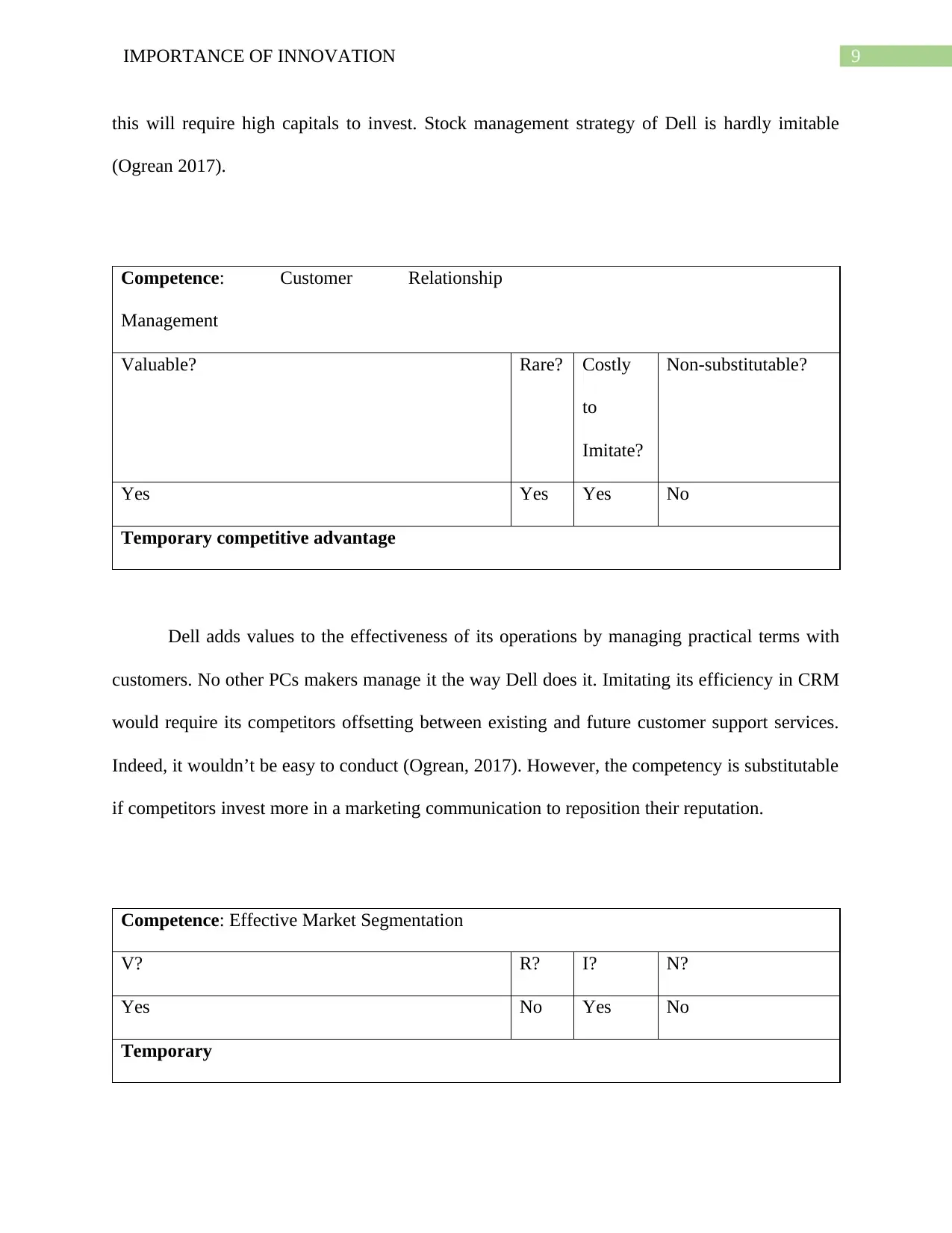
9IMPORTANCE OF INNOVATION
this will require high capitals to invest. Stock management strategy of Dell is hardly imitable
(Ogrean 2017).
Competence: Customer Relationship
Management
Valuable? Rare? Costly
to
Imitate?
Non-substitutable?
Yes Yes Yes No
Temporary competitive advantage
Dell adds values to the effectiveness of its operations by managing practical terms with
customers. No other PCs makers manage it the way Dell does it. Imitating its efficiency in CRM
would require its competitors offsetting between existing and future customer support services.
Indeed, it wouldn’t be easy to conduct (Ogrean, 2017). However, the competency is substitutable
if competitors invest more in a marketing communication to reposition their reputation.
Competence: Effective Market Segmentation
V? R? I? N?
Yes No Yes No
Temporary
this will require high capitals to invest. Stock management strategy of Dell is hardly imitable
(Ogrean 2017).
Competence: Customer Relationship
Management
Valuable? Rare? Costly
to
Imitate?
Non-substitutable?
Yes Yes Yes No
Temporary competitive advantage
Dell adds values to the effectiveness of its operations by managing practical terms with
customers. No other PCs makers manage it the way Dell does it. Imitating its efficiency in CRM
would require its competitors offsetting between existing and future customer support services.
Indeed, it wouldn’t be easy to conduct (Ogrean, 2017). However, the competency is substitutable
if competitors invest more in a marketing communication to reposition their reputation.
Competence: Effective Market Segmentation
V? R? I? N?
Yes No Yes No
Temporary
Paraphrase This Document
Need a fresh take? Get an instant paraphrase of this document with our AI Paraphraser
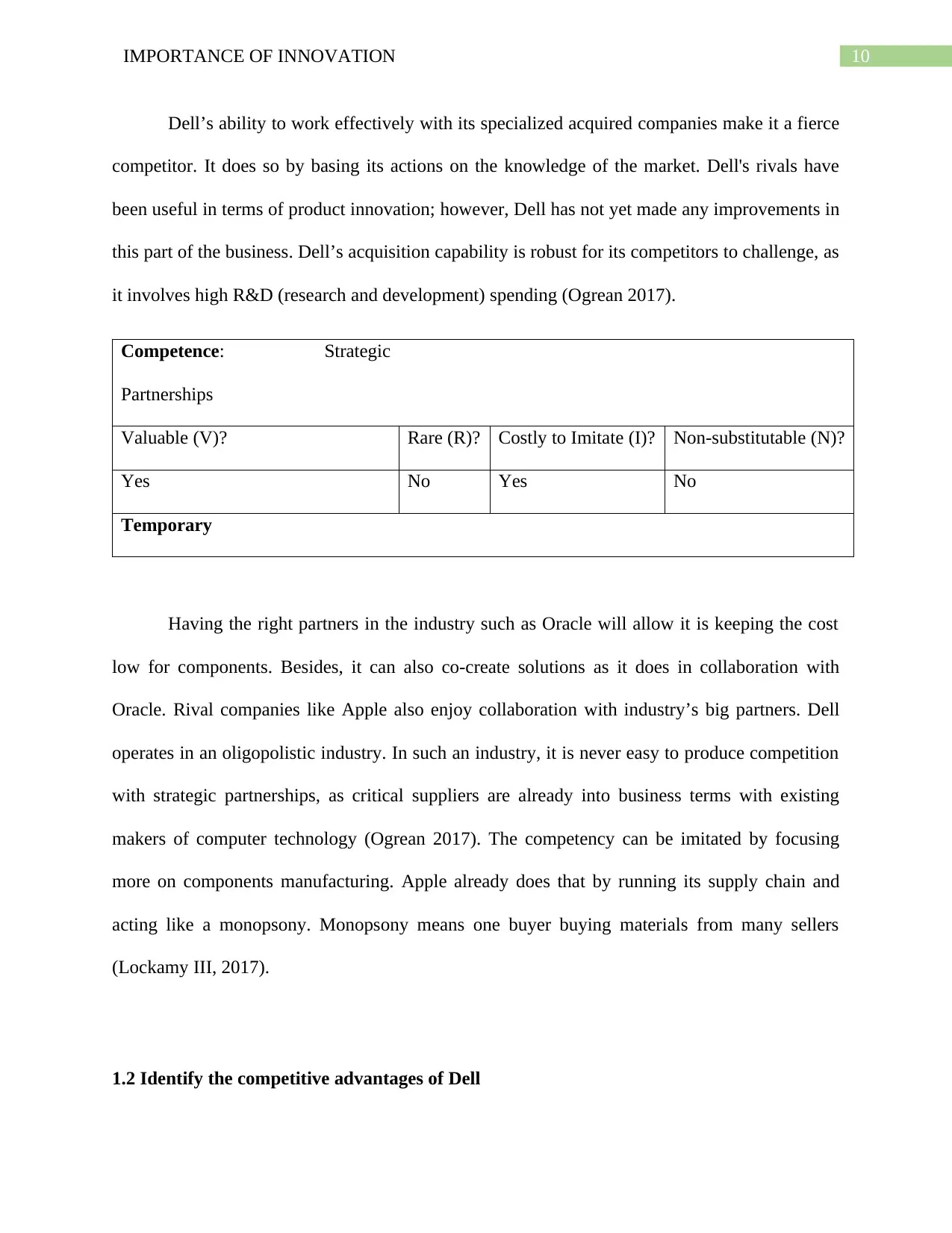
10IMPORTANCE OF INNOVATION
Dell’s ability to work effectively with its specialized acquired companies make it a fierce
competitor. It does so by basing its actions on the knowledge of the market. Dell's rivals have
been useful in terms of product innovation; however, Dell has not yet made any improvements in
this part of the business. Dell’s acquisition capability is robust for its competitors to challenge, as
it involves high R&D (research and development) spending (Ogrean 2017).
Competence: Strategic
Partnerships
Valuable (V)? Rare (R)? Costly to Imitate (I)? Non-substitutable (N)?
Yes No Yes No
Temporary
Having the right partners in the industry such as Oracle will allow it is keeping the cost
low for components. Besides, it can also co-create solutions as it does in collaboration with
Oracle. Rival companies like Apple also enjoy collaboration with industry’s big partners. Dell
operates in an oligopolistic industry. In such an industry, it is never easy to produce competition
with strategic partnerships, as critical suppliers are already into business terms with existing
makers of computer technology (Ogrean 2017). The competency can be imitated by focusing
more on components manufacturing. Apple already does that by running its supply chain and
acting like a monopsony. Monopsony means one buyer buying materials from many sellers
(Lockamy III, 2017).
1.2 Identify the competitive advantages of Dell
Dell’s ability to work effectively with its specialized acquired companies make it a fierce
competitor. It does so by basing its actions on the knowledge of the market. Dell's rivals have
been useful in terms of product innovation; however, Dell has not yet made any improvements in
this part of the business. Dell’s acquisition capability is robust for its competitors to challenge, as
it involves high R&D (research and development) spending (Ogrean 2017).
Competence: Strategic
Partnerships
Valuable (V)? Rare (R)? Costly to Imitate (I)? Non-substitutable (N)?
Yes No Yes No
Temporary
Having the right partners in the industry such as Oracle will allow it is keeping the cost
low for components. Besides, it can also co-create solutions as it does in collaboration with
Oracle. Rival companies like Apple also enjoy collaboration with industry’s big partners. Dell
operates in an oligopolistic industry. In such an industry, it is never easy to produce competition
with strategic partnerships, as critical suppliers are already into business terms with existing
makers of computer technology (Ogrean 2017). The competency can be imitated by focusing
more on components manufacturing. Apple already does that by running its supply chain and
acting like a monopsony. Monopsony means one buyer buying materials from many sellers
(Lockamy III, 2017).
1.2 Identify the competitive advantages of Dell
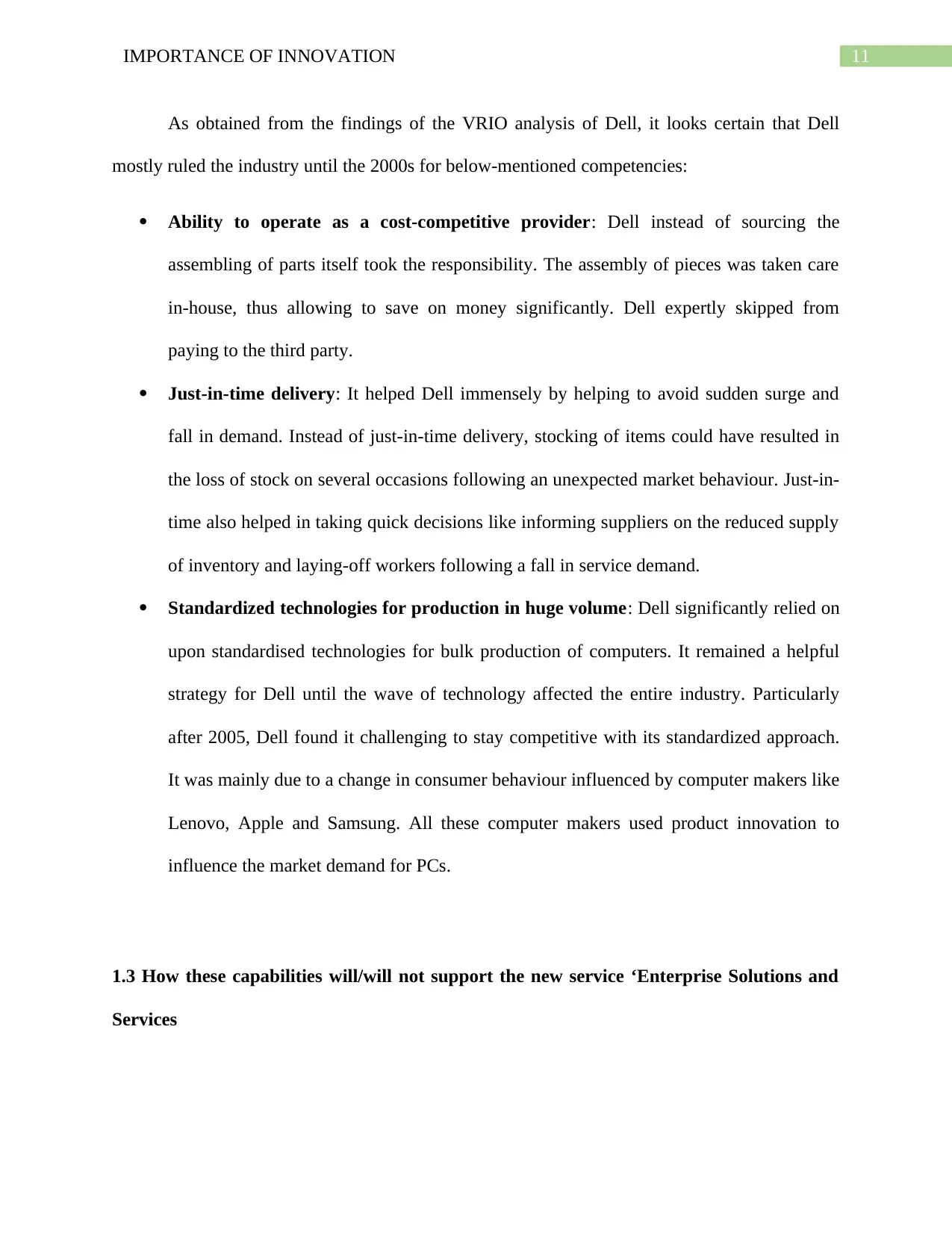
11IMPORTANCE OF INNOVATION
As obtained from the findings of the VRIO analysis of Dell, it looks certain that Dell
mostly ruled the industry until the 2000s for below-mentioned competencies:
Ability to operate as a cost-competitive provider: Dell instead of sourcing the
assembling of parts itself took the responsibility. The assembly of pieces was taken care
in-house, thus allowing to save on money significantly. Dell expertly skipped from
paying to the third party.
Just-in-time delivery: It helped Dell immensely by helping to avoid sudden surge and
fall in demand. Instead of just-in-time delivery, stocking of items could have resulted in
the loss of stock on several occasions following an unexpected market behaviour. Just-in-
time also helped in taking quick decisions like informing suppliers on the reduced supply
of inventory and laying-off workers following a fall in service demand.
Standardized technologies for production in huge volume: Dell significantly relied on
upon standardised technologies for bulk production of computers. It remained a helpful
strategy for Dell until the wave of technology affected the entire industry. Particularly
after 2005, Dell found it challenging to stay competitive with its standardized approach.
It was mainly due to a change in consumer behaviour influenced by computer makers like
Lenovo, Apple and Samsung. All these computer makers used product innovation to
influence the market demand for PCs.
1.3 How these capabilities will/will not support the new service ‘Enterprise Solutions and
Services
As obtained from the findings of the VRIO analysis of Dell, it looks certain that Dell
mostly ruled the industry until the 2000s for below-mentioned competencies:
Ability to operate as a cost-competitive provider: Dell instead of sourcing the
assembling of parts itself took the responsibility. The assembly of pieces was taken care
in-house, thus allowing to save on money significantly. Dell expertly skipped from
paying to the third party.
Just-in-time delivery: It helped Dell immensely by helping to avoid sudden surge and
fall in demand. Instead of just-in-time delivery, stocking of items could have resulted in
the loss of stock on several occasions following an unexpected market behaviour. Just-in-
time also helped in taking quick decisions like informing suppliers on the reduced supply
of inventory and laying-off workers following a fall in service demand.
Standardized technologies for production in huge volume: Dell significantly relied on
upon standardised technologies for bulk production of computers. It remained a helpful
strategy for Dell until the wave of technology affected the entire industry. Particularly
after 2005, Dell found it challenging to stay competitive with its standardized approach.
It was mainly due to a change in consumer behaviour influenced by computer makers like
Lenovo, Apple and Samsung. All these computer makers used product innovation to
influence the market demand for PCs.
1.3 How these capabilities will/will not support the new service ‘Enterprise Solutions and
Services
⊘ This is a preview!⊘
Do you want full access?
Subscribe today to unlock all pages.

Trusted by 1+ million students worldwide
1 out of 24
Related Documents
Your All-in-One AI-Powered Toolkit for Academic Success.
+13062052269
info@desklib.com
Available 24*7 on WhatsApp / Email
![[object Object]](/_next/static/media/star-bottom.7253800d.svg)
Unlock your academic potential
Copyright © 2020–2025 A2Z Services. All Rights Reserved. Developed and managed by ZUCOL.




